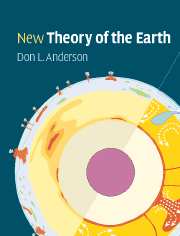Book contents
- Frontmatter
- Contents
- Preface and Philosophy
- Abbreviations and acronyms
- Part I Planetary perspective
- Part II Earth: the dynamic planet
- Chapter 4 The outer shells of Earth
- Chapter 5 The eclogite engine
- Chapter 6 The shape of the Earth
- Chapter 7 Convection and complexity
- Part III Radial and lateral structure
- Part IV Sampling the Earth
- Part V Mineral physics
- Part VI Origin and evolution of the layers and blobs
- Part VII Energetics
- References and notes
- Appendix
- Index
Chapter 7 - Convection and complexity
Published online by Cambridge University Press: 05 June 2012
- Frontmatter
- Contents
- Preface and Philosophy
- Abbreviations and acronyms
- Part I Planetary perspective
- Part II Earth: the dynamic planet
- Chapter 4 The outer shells of Earth
- Chapter 5 The eclogite engine
- Chapter 6 The shape of the Earth
- Chapter 7 Convection and complexity
- Part III Radial and lateral structure
- Part IV Sampling the Earth
- Part V Mineral physics
- Part VI Origin and evolution of the layers and blobs
- Part VII Energetics
- References and notes
- Appendix
- Index
Summary
… if your theory is found to be against the second law of thermodynamics, I can give you no hope; there is nothing for it but to collapse in deepest humiliation.
EddingtonContrary to current textbooks … the observed world does not proceed from lower to higher “degrees of disorder”, since when all gravitationally-induced phenomena are taken into account the emerging result indicates a net decrease in the “degrees of disorder”, a greater “degree of structuring” … classical equilibrium thermodynamics … has to be completed by a theory of ‘creation of gravitationally-induced structures’ …
Gal-orOverview
In 1900 Henri Bénard heated whale oil in a pan and noted a system of hexagonal convection cells. Lord Rayleigh in 1916 analyzed this in terms of the instability of a fluid heated from below. Since that time Rayleigh–Bénard convection has been taken as the classic example of thermal convection, and the hexagonal planform has been considered to be typical of convective patterns at the onset of thermal convection. Fifty years went by before it was realized that Bénard's patterns were actually driven from above, by surface tension, not from below by an unstable thermal boundary layer. Experiments showed the same style of convection when the fluid was heated from above, cooled from below or when performed in the absence of gravity. This confirmed the top-down surface-driven nature of the convection which is now called Marangoni or Bénard–Marangoni convection.
- Type
- Chapter
- Information
- New Theory of the Earth , pp. 73 - 88Publisher: Cambridge University PressPrint publication year: 2007



